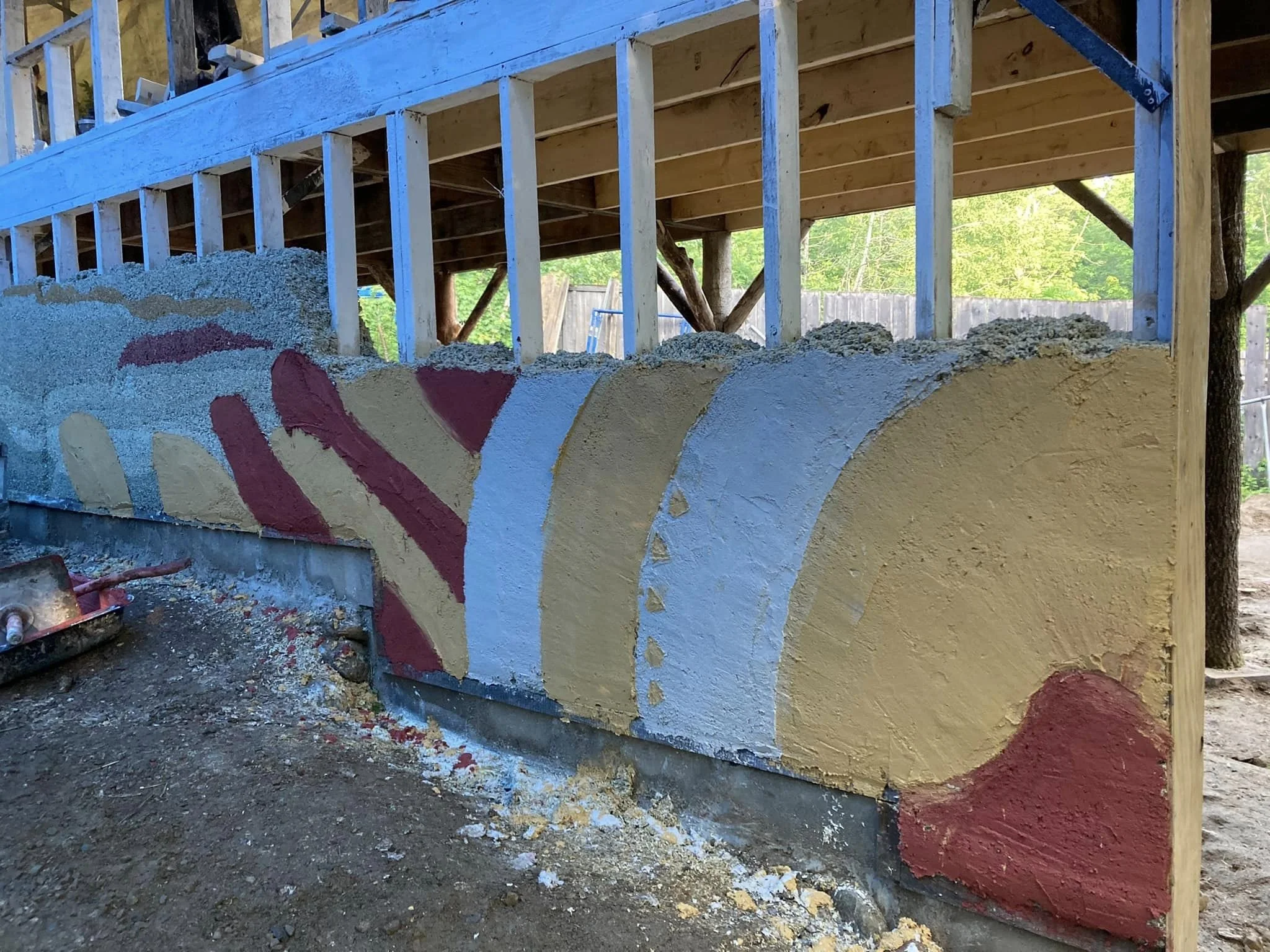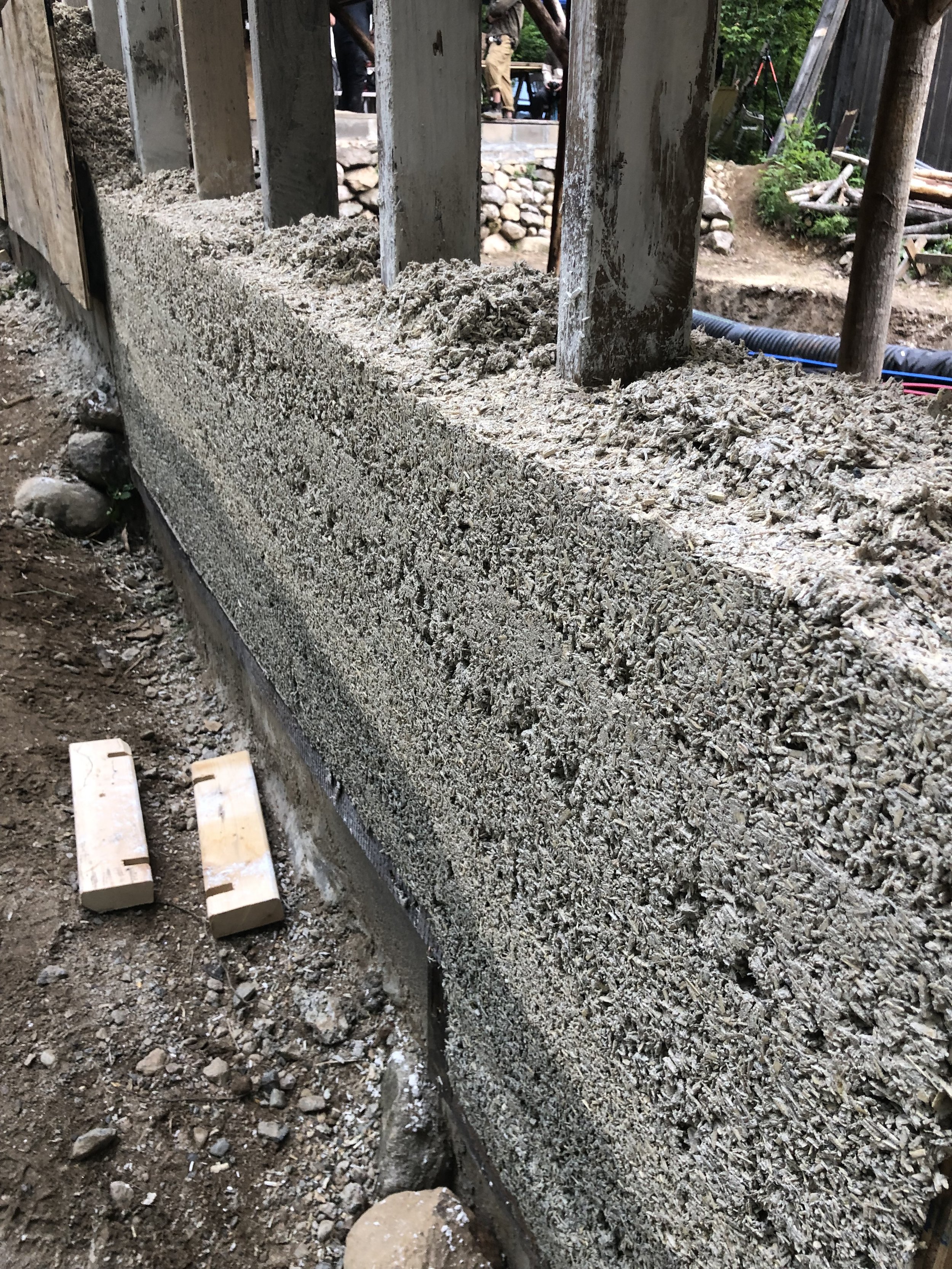Hempcrete Building In-Person Experience + Online Course
Our Hempcrete Building Online Course kicks of Tuesday, July 3rd 2025
…and it will be followed by a 3-Day Workshop & Experience at Sara Lentz’ Community in Alna, Maine, July 17th-20th, 2025.
The online course provides valuable knowledge and insights that students can apply at our in-person workshop in Southern Maine.
The online course includes 90 minutes of educational video content, broken up into 8 modules, with the majority of the footage shared captured at Permatours’ last in-person hempcrete building workshop, held at Diggers Cooperative in June of 2023.
The course offers several interactive sessions on Zoom with our instructor and well-known hempcrete professional, John Patterson of Tiny Hemp Houses.
Students are invited to ask questions and gain clarity on how to implement what they will learn a few weeks later, in-person at our build site.
Students will also get the chance to meet 1-1 with our instructor, John, before and after our group Zoom sessions, so he can get to know students’ personal building experience as well as how they plan to use their newfound skills after the course & in-person event. John tailors the course per the experience level of our students.
In summary, the online course and in-person experience teach students the skills to build with hemp and to create hemp structures of various sizes and shapes, and for different applications.
Hempcrete wall built at a Permatours event, hosted at Diggers Cooperative in Acton, Maine, in June of 2023 (natural plant dyes used to create the red, yellow, & white colors)
Mixing the hempcrete recipe at the Quonset Hut Hemp Cooperative in Fort Collins, Colorado, in August of 2023.
The topics covered online & in-person:
Intro to Construction
Materials needed for building with hemp
How to build with hemp safely
How to mix hempcrete
How to install shuttering
Tamping of the hempcrete
Plastering with hempcrete
Making floors, walls, and ceilings with hempcrete
Hemp History & The Benefits Of Working With It As A Building Material
Hemp Throughout History
Hemp has a long and rich history in human civilization. From the earliest days, humans have consumed hemp as a food source, used it for textiles and clothing, and even built homes with it. There is documentation of caves constructed with a hempcrete-like material dating back around 3,000 years.
By the early 1700s, industrial hemp was significant in New England. European settlers used hemp for essential maritime purposes: the sails of their ships and the ropes that hoisted those sails were made from hemp. This critical resource played a vital role in their transatlantic journeys.
Before 1937, hemp was integral to many aspects of daily life in the United States. It provided much of our food, clothing, energy, medicine, income, and shelter. Additionally, at the turn of the century, cannabis medicine was a staple in drugstores nationwide, used in sleep medication, pain relief, children's cough syrups, and many other products.
However, the rise of other industries, as well as economic and political schemes, led to a shift. The pharmaceutical industry began producing more synthetic medicines, cotton farmers and textile producers increased their output, and paper mills expanded their manufacturing. These industries saw hemp and cannabis as direct competitors threatening their profits. The emerging plastics industry and oil companies also viewed hemp as a threat because it could be used to produce biodegradable plastics and biofuels. The timber industry was concerned about hemp's potential to replace wood pulp in paper production, and the rope and cordage industries worried about hemp's superior qualities.
Political intentions also played a significant role in the prohibition of cannabis and hemp. Influential figures and industries lobbied for legislation to eliminate their competition. The 1937 Marihuana Tax Act, introduced under the guise of controlling a dangerous drug, was primarily driven by economic interests. Media moguls like William Randolph Hearst, with substantial investments in timber for paper production, and industrialists like DuPont, whose new synthetic fibers faced competition from hemp, were instrumental in this campaign.
In addition to economic motivations, the prohibition of cannabis and hemp was used as a tool to marginalize minorities. The campaign against cannabis was heavily racialized, with propaganda linking its use to African American and Mexican communities negatively. Sensationalized stories and racist rhetoric were used to incite fear and justify the crackdown on cannabis. This led to disproportionate targeting and criminalization of minorities, further entrenching social and racial inequalities.
As a result, almost overnight, cannabis medicine was wiped from drugstores across the United States, and the cannabis and hemp prohibition era began.
What is Hempcrete?
Hempcrete is a sustainable building material made from a mixture of hemp hurds (the inner woody core of the hemp plant), lime, and water.
Hempcrete is used primarily for constructing non-load-bearing walls and insulation in buildings - providing a green alternative to traditional building materials.
Cover image of an article about Permatours’ Hempcrete Building Workshop hosted at Diggers Co-op in Southern, ME, June 2023 (article starts on page “28”)
The Benefits of Hempcrete
Hempcrete is a sustainable building material celebrated for its excellent insulating properties, low environmental impact, and ability to improve indoor air quality. It is fire-resistant, energy-efficient, pest-proof, vapor-permeable, mold and mildew resistant, and requires less maintenance. Additionally, hempcrete sequesters carbon, making it an eco-friendly choice.
One of the key benefits of hempcrete is its thermal and acoustic insulation, which makes buildings more energy-efficient and reduces heating and cooling costs. Its pest-proof quality is due to the presence of lime, which rodents dislike. Hempcrete’s mold and mildew resistance also contributes to its durability and long lifespan, potentially lasting several decades to over 100 years when properly constructed and maintained.
Hempcrete's environmental benefits are significant. Hemp is a fast-growing crop that requires minimal pesticides and herbicides, and the lime used in hempcrete absorbs CO2 as it cures, lowering the carbon footprint. Though not as strong as concrete, hempcrete is lightweight and can be used with a structural frame for building walls and other structures.
Its breathability allows moisture to pass through without retaining it, reducing the risk of rot and decay. This breathability, combined with its fire resistance, enhances the safety and longevity of hempcrete structures.
Finally, hemp homes can also offer a high luxury look and feel, making them an attractive option for sustainable building. Ready to harness the power of earth-friendly construction?
To summarize, hempcrete offers:
Excellent insulation: Provides thermal and acoustic insulation, making buildings more energy-efficient.
Environmental sustainability: Made from fast-growing hemp that requires minimal pesticides and herbicides.
Carbon sequestration: Lime in hempcrete absorbs CO2 as it cures.
Pest resistance: Lime deters rodents.
Mold and mildew resistance: Natural properties reduce the risk of decay.
Breathability: Allows moisture to pass through, preventing rot.
Fire resistance: Enhances building safety.
Durability: When properly constructed and maintained, can last several decades to over 100 years.
Enroll in our Hempcrete Building Online Course and In-Person Workshop Today and start creating eco-friendly structures that stand the test of time!
The crew of Hempcrete Building Certified folks, who attended Permatours’ Hempcrete Building Workshop at Diggers Co-op in Acton, ME (June, 2023)
Can you make hempcrete at home?
Yes, you can make hempcrete at home, although it requires some specific materials and equipment. Here’s a basic guide on materials and equipment needed:
Materials Needed
Hemp Hurds (Shiv): The woody core of the hemp stalk.
Lime Binder: Typically a mixture of hydrated lime and possibly other components like sand or pozzolans.
Water: Clean water for mixing.
Note: To learn more about the quantities needed of each ingredient in your mixture, enroll in our hempcrete in-person workshop (which comes with an online course)!
Equipment Needed
Mixing Tools: A large mixing container or a concrete mixer.
Protective Gear: Gloves, goggles, and a mask to protect from lime dust.
Formwork: Molds or forms to shape the hempcrete.










